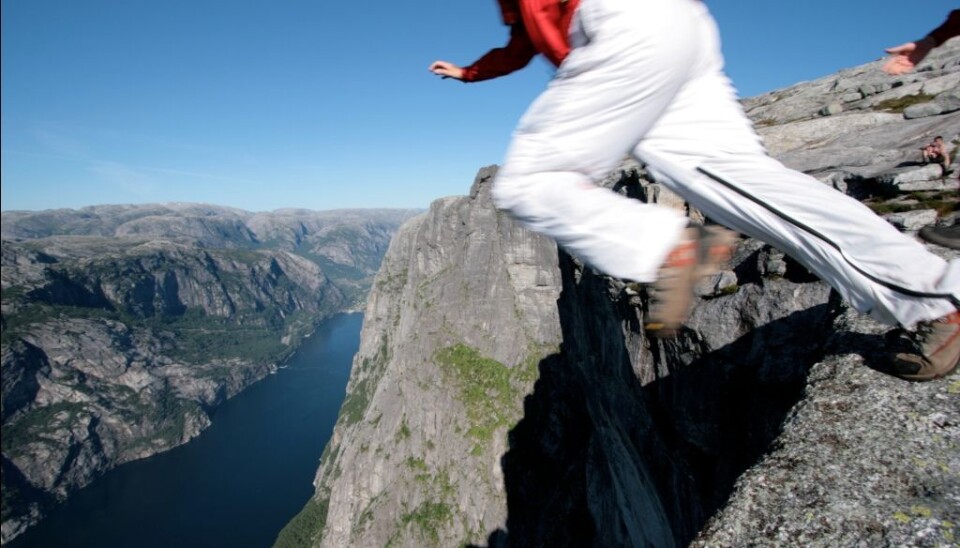An article from University of Tromsø – The Arctic University of Norway

Living on the edge with base jumping
Base jumpers may seem like they are tempting death, but they do it to feel that they have mastered life.
Denne artikkelen er over ti år gammel og kan inneholde utdatert informasjon.
What looks like contempt for death and pure madness to some, is a celebration of life to others.
Ryan Saunders’s breath comes in short, percussive blasts. He looks down at his feet, which are still firmly planted on solid ground. He glances around him, and then slowly lifts his head, as if he is just coming to grips with what is about to happen.
The edge is just a few centimetres away, and then from there it is a few hundred metres to a short steep hill. He has to follow the mountainside closely while ensuring that he has enough lift to clear the steep rise in the landscape below.
If he clears it, he then has another 200 metres to fall before he has to pull the cord on his parachute.
He has tried this particular jump six times before. He's gone through them all in his head, time and again, planning, calculating, and then taking the leap. And then coming up short.
He steps closer to the edge. "Three, two, one!"
For just a fraction of a second it seems completely silent. But then comes the deafening sound of the air racing past Ryan's helmet camera and ripping through the speakers.
Ryan has jumped and the ground is getting closer dangerously fast.
They must be crazy
Anyone who sees a base jumper dive off the edge of a mountain cliff has to wonder what is going on in that person's head. Most will say that he or she is crazy.
When you only see the action and not the reasoning behind it, it looks like madness.
“But I thought that there must be something really great about base jumping since there are so many people who are willing to take the risk. They don't deny that it is dangerous, but they also don't think that it will end badly," says PhD candidate Audun Hetland.
He has explored the feelings experienced by base jumpers when they do what they like best.
Lust for life
Is it a death wish or contempt for death that causes these young men and women to step over the edge?
"It's certainly not a death wish. They assume they will survive, but that's not the goal in itself,” says Hetland.
He says these are people who really love life and who do all that they can to minimize the risk.
The paradox is that if it was absolutely safe to do base jumping, the thrill of the experience itself would disappear.
In his study Hetland repeatedly measured the pulse of 13 base jumpers after the jump. He also asked them to describe what they felt during the jump.
But right after completing a jump, the release of tension is so tremendous that most of the jumpers were nearly speechless and could not express their feelings in words. So Hetland asked them to draw a curve to explain how they felt.
The first thing that happens when they step over the edge is a feeling of fear and discomfort.
"They feel fear, but much less than you would expect," says Hetland.
Fear and distress occur in situations where they have the least control, such as when they first jump off the cliff or pull the cord on their parachute.
“That is also when they have the highest adrenaline levels. A base jumper's motivation is the desire to grow as a human being, and they realize that requires leaving their comfort zone."
In free fall
Base jumper Ryan uses his eyes to measure the distance to the ground. It seems as if it just flows past, only a few tens of centimetres from his helmet-mounted video camera.
He must fly quite close to the mountain wall, because even though he is making good progress, the clearance between him and the rise in the landscape is dangerously small.
Gravel and boulders race up at him at a furious pace. He steers his body towards the hill.
It is now or never.
Suddenly it seems as if he is flying into the treetops on the mountainside. Then the little rise disappears and it gets steeper. He is over the hump. He floats. And the lens on his camera begins to fog up.
The first jump is not the best
Most base jumpers start as parachutists and jump for many years before they throw themselves off their first vertical wall.
The first jump is not at all pleasant, they say. It takes about ten or fifteen jumps before they feel that they have enough control of the situation to enjoy the experience.
But what drives them to continue through the unpleasantness is the confidence that they will eventually be able to master the situation, according to Hetland.
After ten or fifteen jumps they have more control and more time to absorb the feeling. They usually begin with high mountains.
The mountain's 1000 metre drop allows for 25 seconds of free fall. In the few seconds where they feel like they are actually flying, they are moving at nearly 180 kilometres an hour.
"You can almost touch the air. Everything is completely still. Time goes very slowly, you have the feeling that everything has slowed to half speed," says Hetland. “You are very present in your environment. They describe being able to fly like a swallow as a fantastic experience.”
Not a sport for macho men
According to Hetland they are nor adrenaline junkies.
"Macho men do not live long doing this sport,” he says.
Base jumpers are mostly sober-minded outdoor enthusiasts. They don't needlessly seek out dangerous situations. Some even think it's scary to paint the house, because they have to stand on a ladder.
Hetland explains that base jumping is all about excelling at what you do and doing your utmost to complete the jump. In fact, it is not all that different from what a concert pianist goes through during a concert.
“For both, the adrenaline rush is mainly a source of discomfort, not a goal in itself. Completing a successful jump requires mastering the situation and the adrenaline rush."
Only three ways to stop
Ryan Saunders's jump is coming to an end. Suddenly you can hear the sound of fabric cracking in the wind and through the fog on the lens, you can see the dark shadow of the parachute over Ryan's head.
His body jerks up. For just a few tenths of a second it is completely quiet. But as Ryan Saunders makes his landing, you can hear a yelp of pure joy.
The joy of succeeding is overwhelming and the feeling of happiness is all encompassing once you have made a successful landing.
But to continue to achieve this feeling of extreme happiness, base jumpers have to operate with increasingly smaller margins of safety.
As they become increasingly better at what they do, they often attempt more difficult jumps − either by wearing wing suits, or jumping from lower mountaintops, or from houses, bridges or antenna towers.
"One of the best base jumpers told me that the average length of a jumper's career is six years, and that there are three ways to stop: to die, to be injured, or to realize that the risk is simply too great," says Hetland.
The range of feelings in base jumpers is enormous.
"It's pretty amazing. The strongest feeling is engagement. It seems as if the human mind can tolerate a great deal, as long as a person is doing something that is interesting,” says Hetland.
So you might ask how people arrange these kinds of experiences in their everyday life, without having to jump off of a mountain.
"Yes, fucking yes! That was fucking awesome! I don't care if I sound like a fucking retard but that was fucking awesome! I did it! I did it!"
Shouts of joy bounce between the valley walls. Ryan lives to jump another day.
































